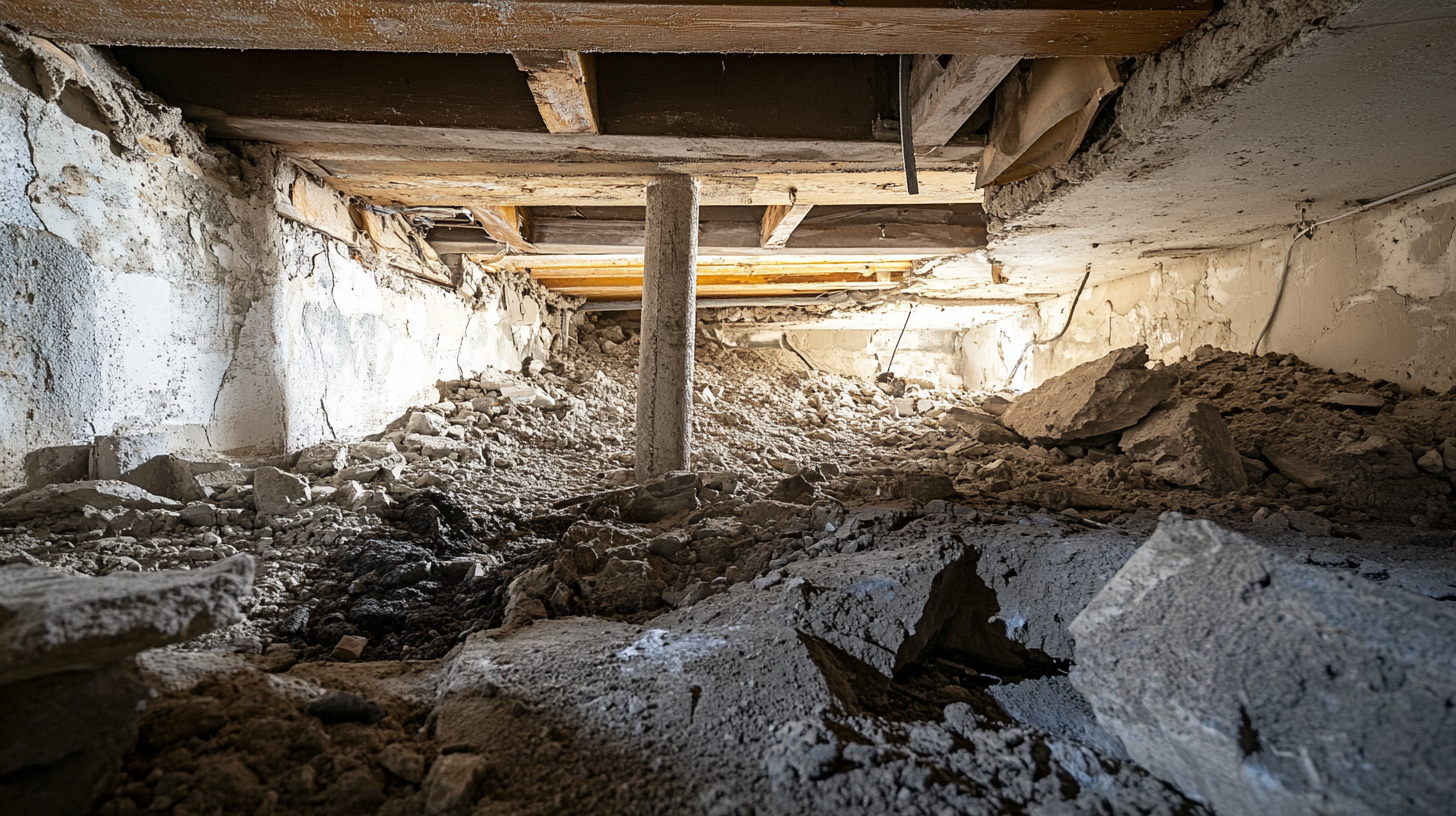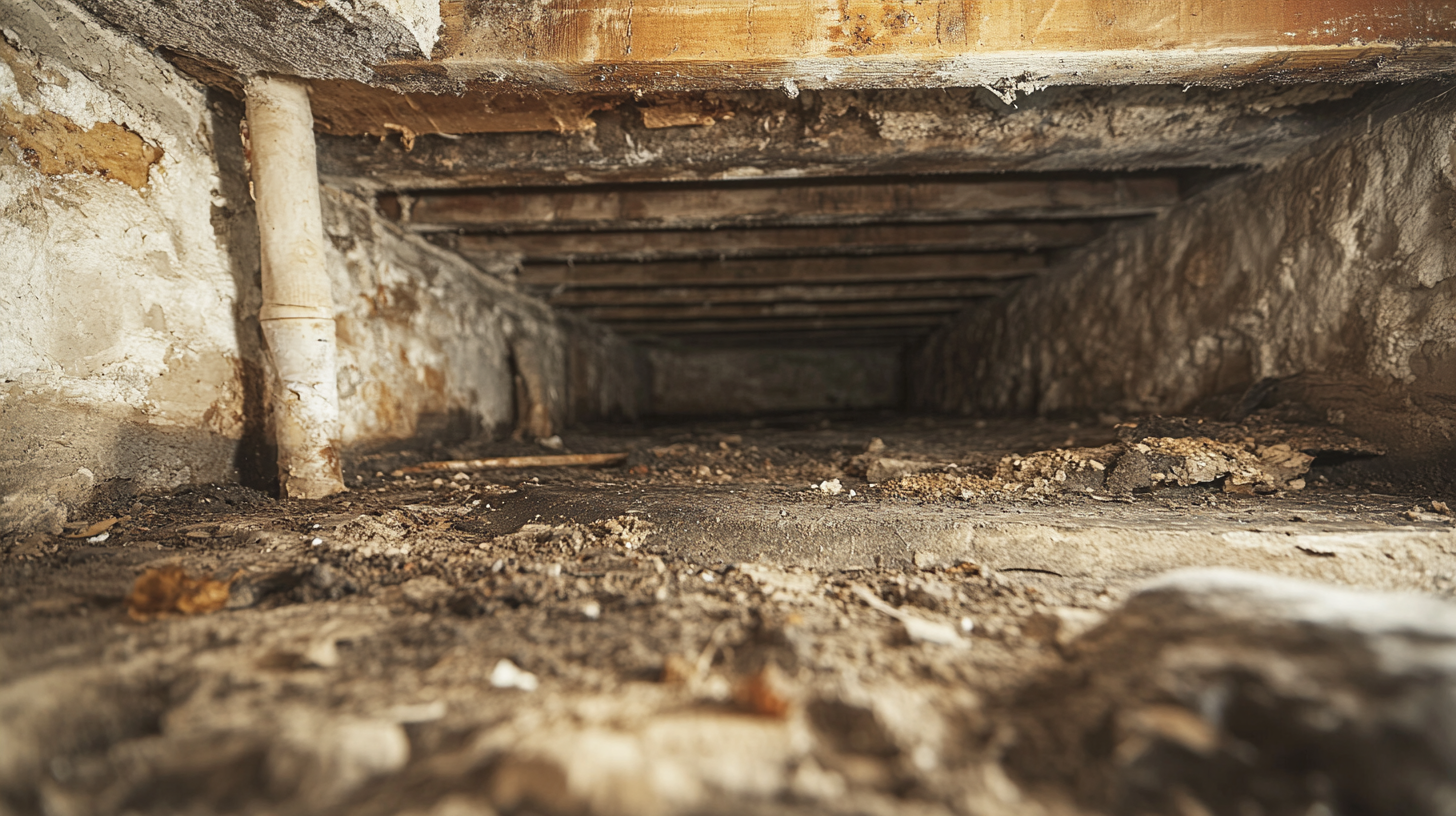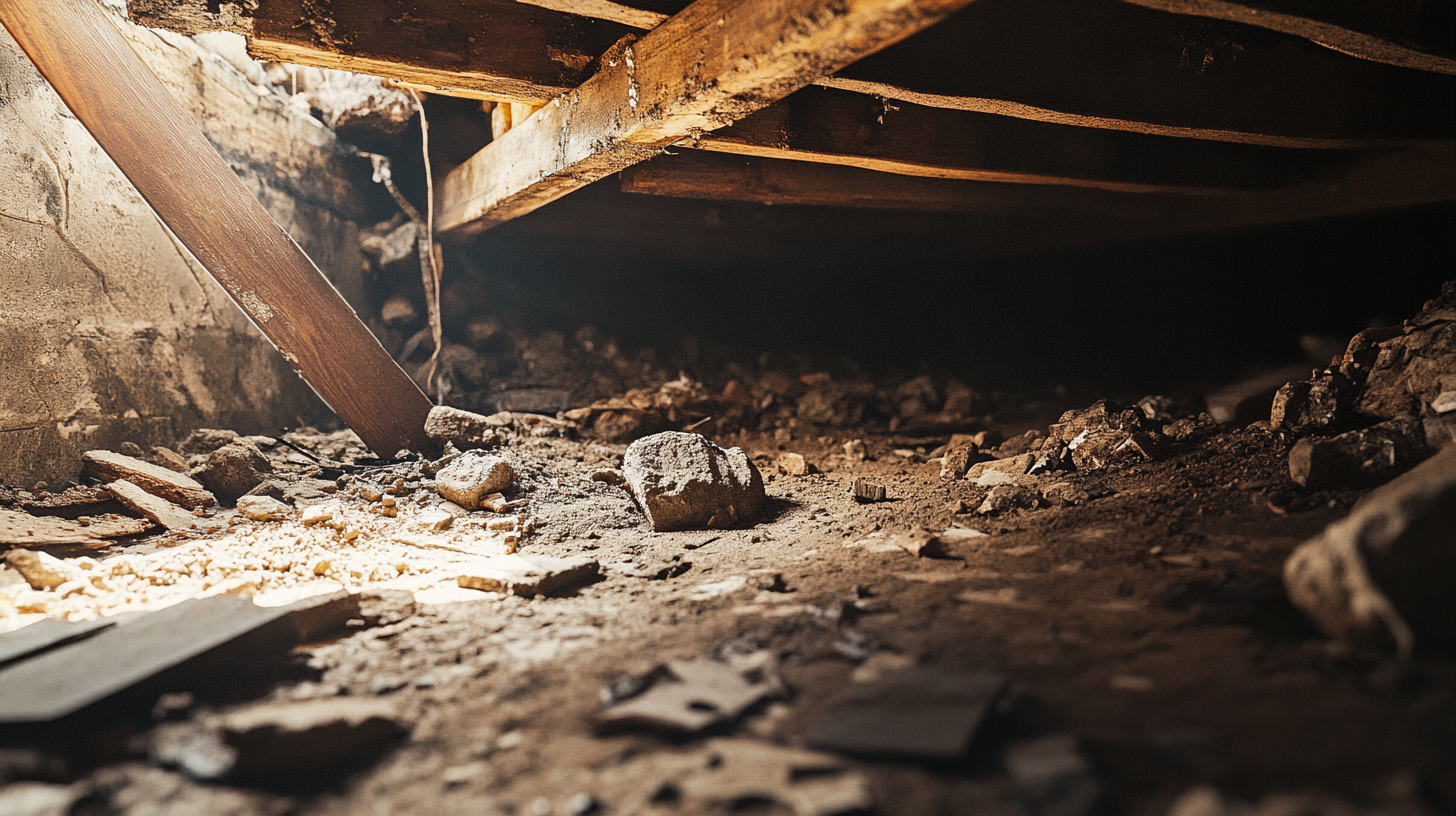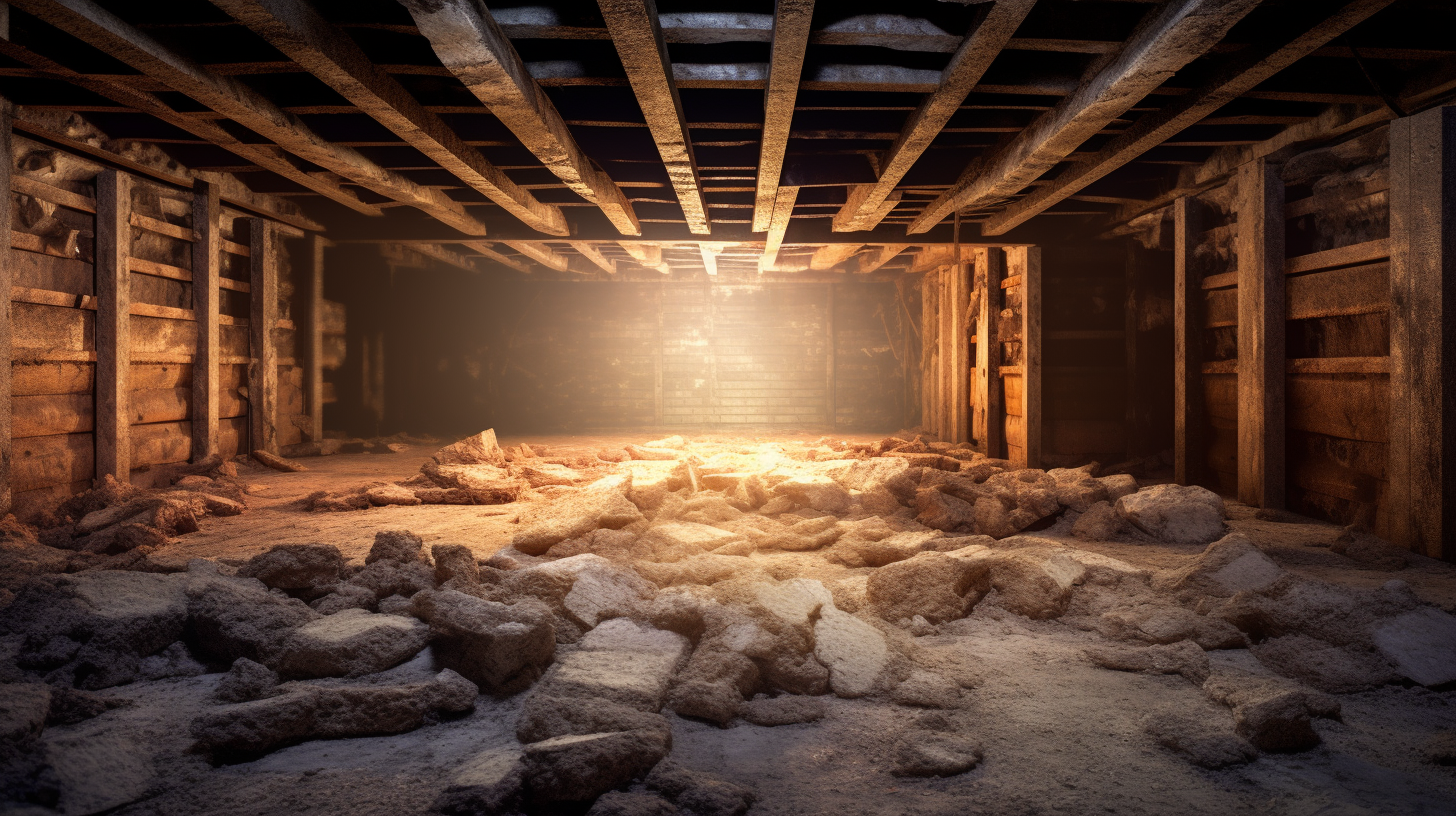Welcome to our comprehensive guide on the vital importance of identifying damage signs in your home's foundations and crawl spaces. As homeowners, one of our primary concerns is ensuring the safety and longevity of our living spaces. This blog delves into the often-overlooked yet crucial aspect of home maintenance: the early detection of potential issues in the structural integrity of our homes.
Why This Matters:
The foundation of a home is much like the roots of a tree – essential for stability and health. Damage to this foundational structure, often hidden away in crawl spaces, can be a silent culprit leading to significant problems if left unchecked. Understanding the signs of damage not only helps in maintaining the structural integrity of your home but also plays a pivotal role in safeguarding the well-being of its occupants.
The Cost of Neglect:
Ignoring early warning signs can lead to exponentially more significant issues, resulting in costly repairs. This blog aims to empower you with the knowledge to identify these early signs of damage. By doing so, you can take proactive steps to address minor issues before they escalate into major concerns, thereby ensuring the safety of your home and potentially saving thousands in repair costs.
What You Will Learn:
Through this blog, we will guide you through:
- Identifying Key Signs of Damage: Learn to spot the early indicators of foundation and crawl space damage, from visible cracks to subtle shifts.
- Understanding the Implications: Comprehend why these signs are more than just cosmetic issues and how they can impact the overall safety of your home.
- Preventive Measures and Solutions: Discover practical steps and solutions to address these issues promptly, ensuring the longevity and safety of your home.
Join us as we explore the essential practice of recognizing and addressing foundation and crawl space damage, a key component in maintaining a safe and secure home environment.
Fundamentals of Foundation and Crawl Space Structures
Understanding the fundamentals of foundation and crawl space structures is crucial for any homeowner. These elements are the bedrock of your home’s stability and overall health. In this section, we delve into the roles and importance of these structures and explore the common materials and construction methods used.
Role and Importance of Foundations and Crawl Spaces
Structural Support and Integrity of Homes:
The foundation is more than just the lowest part of your house – it's the component that supports everything above it. It bears the weight of your entire home, ensuring stability and structural integrity. Similarly, crawl spaces, though often out of sight, play a pivotal role in the health of your home. They allow for air circulation, provide access to plumbing and electrical systems, and can be crucial in preventing moisture buildup that leads to mold and structural damage.
Impact on Overall Home Health:
A well-constructed foundation and crawl space not only support the physical structure of a home but also contribute to its overall health. Issues in these areas can lead to significant problems like uneven flooring, cracks in walls, and in severe cases, major structural failures. Moreover, the condition of your crawl space can directly impact the air quality inside your home, as moisture and mold issues below can seep into your living spaces.
Common Materials and Construction Methods
Types of Foundations and Crawl Space Constructions:
Foundations come in various types, each suited to different environmental conditions and building requirements. The most common types include slab-on-grade, crawl space, and basement foundations. Slab-on-grade is a single layer of concrete laid over the ground; it’s simple, cost-effective, and suitable for climates where the ground does not freeze. Crawl space foundations, on the other hand, elevate the house off the ground, providing space for air circulation and access to utilities. Basement foundations offer additional living or storage space and are common in colder climates where the foundation needs to be placed below the frost line for stability.
Each foundation type requires specific materials and construction methods. For instance, concrete is a popular choice for its strength and durability, while block foundations are favored for their ease of installation and cost-effectiveness. The choice of material and construction method depends on various factors, including climate, soil type, and the specific needs of the building.
Recognizing Foundation Damage Signs
Identifying early signs of foundation damage is crucial in maintaining the integrity and safety of your home. Foundation issues can manifest in various ways, and early detection can save homeowners from costly repairs in the future. This section covers the key indicators of foundation damage, including visible cracks, uneven floors, and issues with doors and windows.
Visible Cracks and Fractures
Types of Cracks and Their Implications:
Cracks in the foundation are not just a cosmetic issue; they can be significant indicators of underlying problems. There are several types of cracks, each signaling different issues:
- Hairline Cracks: These are common in new homes and often result from the concrete curing process. While usually not a major concern, they should be monitored.
- Horizontal Cracks: These can be a sign of serious structural problems, often caused by hydrostatic pressure from the soil outside the foundation.
- Vertical Cracks: Typically less severe than horizontal cracks, they can occur due to minor settling of the foundation. However, they can become problematic if they allow water infiltration.
Understanding the type and location of cracks is essential in assessing the severity of foundation issues.
Uneven or Sinking Floors
How Foundation Issues Can Lead to Uneven Flooring:
Uneven or sinking floors are a telltale sign of foundation problems. When a foundation shifts or settles unevenly, it can cause the floors to become unlevel. This issue is often more noticeable in homes with crawl spaces or basements. Signs include sloping floors, gaps between the floor and walls, or a bouncing feeling when walking. These symptoms indicate that the foundation may be moving, and addressing these issues early can prevent more significant damage.
Doors and Windows That Stick or Won't Close Properly
Alignment Issues as Indicators of Foundation Damage:
Doors and windows that stick or won't close properly can be more than just an annoyance; they can be signs of foundation issues. When a foundation shifts, it can distort the frame structures of a house, leading to misaligned doors and windows. Difficulty opening or closing them, or visible gaps around the frame, can indicate that the foundation has moved. These alignment issues are important to address, as they can affect both the functionality and energy efficiency of your home.
Identifying Crawl Space Damage Signs
Crawl spaces, often overlooked, play a crucial role in the overall health of your home. Damage in these areas can lead to significant problems if not addressed promptly. Recognizing the signs of damage in your crawl space is key to maintaining a healthy, safe, and efficient home. This section explores the common indicators of crawl space damage, including moisture and mold growth, pest infestations, and insulation deterioration.
Moisture and Mold Growth
Signs of Excessive Moisture and Potential Mold Infestation:
Moisture in crawl spaces can be a silent menace, leading to mold growth and structural damage. Signs of excessive moisture include:
- Visible Mold or Mildew: These fungi thrive in damp environments and can often be seen or smelled in crawl spaces.
- Condensation: Look for water droplets on pipes, walls, or floors, indicating high humidity levels.
- Rotting Wood: Excessive moisture can cause wooden structures to rot, compromising the structural integrity of your home.
- Increased Humidity in Living Areas: Moisture from the crawl space can seep into your home, leading to higher overall humidity levels.
Addressing moisture issues promptly can prevent mold infestation and protect the structural integrity of your home.
Pest Infestations
Indicators of Pests or Rodents That Often Signal Crawl Space Issues:
Pests and rodents are not just a nuisance; they can indicate underlying issues in your crawl space. Signs of infestation include:
- Droppings or Nesting Materials: The presence of these can signal an infestation of rodents or insects.
- Damaged Insulation or Wiring: Pests often chew through materials, leading to further damage.
- Unusual Noises: Scratching or scurrying sounds can indicate the presence of rodents.
- Entry Points: Look for holes or cracks that pests might use to enter the crawl space.
Effective pest control and sealing off entry points can help mitigate these issues.
Insulation Deterioration
How Damaged Insulation Can Point to Broader Crawl Space Problems:
Insulation in crawl spaces is vital for maintaining energy efficiency and comfort in your home. Signs of insulation damage include:
- Sagging or Wet Insulation: This can indicate moisture problems, as insulation loses its effectiveness when wet.
- Pest Damage: As mentioned earlier, pests can damage insulation, reducing its effectiveness.
- Energy Inefficiency: If your energy bills are rising or you notice uneven temperatures in your home, it could be due to insulation issues in the crawl space.
Regular inspections and maintenance of crawl space insulation are crucial for the overall energy efficiency and comfort of your home.
Causes of Foundation and Crawl Space Damage
Understanding the causes of foundation and crawl space damage is essential for homeowners to maintain the integrity and safety of their homes. Various factors, ranging from environmental conditions to the natural aging process, can contribute to these issues. This section explores the primary causes, including environmental and soil-related factors, as well as the impact of age and wear on these critical structures.
Environmental and Soil-related Factors
How Soil Types and Moisture Levels Impact Foundations and Crawl Spaces:
The type of soil your home is built on and the moisture levels within it play a significant role in the health of your foundation and crawl space. Key considerations include:
- Expansive Soil: Certain soils, like clay, expand when wet and shrink when dry, leading to movement and potential damage to foundations.
- Soil Erosion: Water flow can erode soil under foundations, causing uneven settling and cracks.
- Poor Drainage: Inadequate drainage can lead to water accumulation around the foundation, increasing hydrostatic pressure and moisture-related issues in crawl spaces.
- Frost Heave: In colder climates, the freezing and thawing cycle can cause soil to heave, impacting the foundation.
Proper soil management and drainage are crucial in mitigating these risks.
Age and Wear
The Impact of Time and Neglect on Structural Integrity:
Over time, all structures undergo wear and tear, and foundations and crawl spaces are no exception. Factors contributing to age-related damage include:
- Material Deterioration: Building materials, over time, can deteriorate, especially if not properly maintained.
- Settling and Shifting: Natural settling of the ground over time can lead to shifts in the foundation, causing cracks and structural issues.
- Corrosion of Supports: In crawl spaces, metal supports can corrode, especially in damp environments, weakening structural integrity.
- Neglect: Lack of regular maintenance and inspections can lead to minor issues developing into major problems.
Regular inspections and maintenance are key to identifying and addressing age-related wear and tear before they become serious issues.
DIY Inspection Tips
Conducting a DIY inspection of your home's foundation and crawl spaces can be a proactive way to ensure the health and safety of your living space. However, it's crucial to approach this task with the right knowledge and precautions. This section provides essential tips for safely conducting a DIY home inspection, covering the necessary safety measures and a step-by-step guide to inspecting foundations and crawl spaces.
Safety First: Preparing for a Home Inspection
Necessary Precautions and Safety Gear:
Before embarking on a DIY inspection, prioritize your safety with the following precautions and gear:
- Personal Protective Equipment (PPE): Wear appropriate safety gear, including gloves, a dust mask, and a hard hat, to protect against potential hazards.
- Adequate Lighting: Ensure you have a reliable flashlight or headlamp, as crawl spaces can be dark and poorly lit.
- Avoid Electrical Hazards: Be cautious of electrical wiring, especially in older homes. If unsure, consult a professional.
- Pest Precautions: Be aware of the potential for pests and insects. If there are signs of infestation, it may be safer to call a professional.
- Structural Stability: Be mindful of the stability of the area you are inspecting. Avoid putting weight on weak or damaged floors.
Step-by-Step Guide to Inspecting Foundations and Crawl Spaces
Key Areas and Elements to Inspect:
Follow this guide to thoroughly inspect your foundation and crawl spaces:
- Start with a Visual Inspection: Look for obvious signs of damage like cracks, water damage, or mold growth on the exterior and interior walls of the foundation.
- Check for Cracks: Pay special attention to different types of cracks - hairline, horizontal, vertical - and note their locations and severity.
- Inspect for Moisture: Look for signs of dampness, water stains, or pooling water, which can indicate drainage issues or leaks.
- Evaluate the Condition of Insulation: In crawl spaces, check if the insulation is intact, sagging, or shows signs of moisture damage.
- Look for Pest Evidence: Be on the lookout for droppings, nesting materials, or damage caused by pests.
- Assess Ventilation: Ensure that crawl spaces are adequately ventilated to prevent moisture buildup.
- Document Your Findings: Keep a record of any issues or potential problems for future reference or professional evaluation.
FAQs
Contact Trench Guys Today!
Trench Guys will do everything we can to ensure your experience with us is excellent.
Request A FREE Estimate
Request a Free Estimate Form
Checkout Recent Post




Got a Question? We’re Here to Help.
You can arrange an appointment or make an enquiry by phone or email, orget in touch to us via our contact form.



